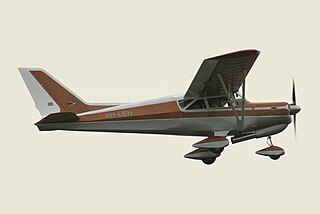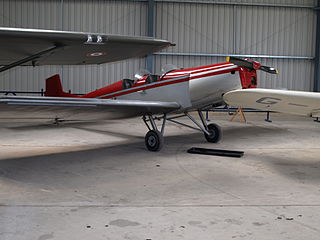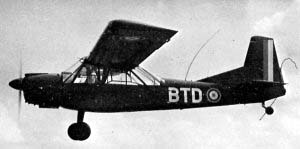Related Research Articles

The Piper PA-24 Comanche is an American four-seat or six-seat, low-wing, all-metal, light aircraft of semi-monocoque construction with tricycle retractable landing gear. Piper Aircraft designed and developed the Comanche, which first flew on May 24, 1956. Together with the PA-30 and PA-39 Twin Comanche, it made up the core of the Piper Aircraft lineup until 1972, when the production lines for both aircraft were wiped out in a flood.

The Peterson 260SE is a STOL conversion of a Cessna 182 airframe made by Todd Peterson. The conversion consists of the addition of a high-lift canard and a 260 hp (194 kW) engine.

The Canadair CL-66 was a turboprop version of the civilian Convair CV-440 Metropolitan. The CC-109 Cosmopolitan or "Cosmo" in RCAF service became the standard VIP aircraft as well as replacing the Douglas Dakota and the North American B-25 Mitchell in light transport duties. After a lengthy career stretching into the 1990s, the CC-109 was replaced by the CC-142 Dash 8 and CC-144 Challenger.

The Helio Twin Courier is a twin-engined version of the Helio Courier, with very few examples being produced.

The Aérospatiale N 262 is a French twin-turboprop high-wing airliner built first by Nord Aviation. The aircraft was also known as the Nord 262.

The Soko J-20 Kraguj (Sparrowhawk) is light military, single-engine, low-wing single-seat aircraft with a metal airframe, capable of performing close air support, counter insurgency (COIN), and reconnaissance missions, that was designed by VTI and manufactured by SOKO of Yugoslavia, first flown in 1962.

The Nord Aviation 3202 was a 1950s French military trainer aircraft designed and built by Nord Aviation to meet a French Army requirement for a two-seat basic trainer, as a replacement for the biplane Stampe SV.4. Altogether, 101 examples were built, with the first flying on 17 April 1957.

The Beagle A.109 Airedale was a British light civil aircraft developed in the 1960s.

The Reid Rambler, later known under the Curtiss-Reid brand after Reid was purchased by Curtiss, was a biplane trainer/sport aircraft built in Canada in the early 1930s and used in small numbers as a trainer aircraft by the Royal Canadian Air Force.

The Druine D.5 Turbi was a light aircraft designed in France in the 1950s for home building. It was a low-wing cantilever monoplane with fixed tailskid undercarriage. The pilot and a single passenger sat in tandem, open cockpits. Essentially a scaled-up version of the Druine Turbulent design, the Turbi shared that aircraft's wooden construction. Again, like its predecessor, it was intended to be able to be powered by a variety of air-cooled engines.

The PZL-102 Kos (blackbird) is a Polish two-seat touring and training monoplane designed and built by PZL.

The Potez 840 was a 1960s French four-engined 18-passenger executive monoplane, the last aircraft to use the Potez name.

The Wing D-1 Derringer is an American light twin-engined two-seat monoplane tourer designed by John Thorp and developed by the Hi-Shear Corporation and built by the Wing Aircraft Company.

The Nord 3400 Norbarbe was a French two-seat observation and casualty-evacuation aircraft built by Nord Aviation for the French Army Light Aviation.

The Payne Knight Twister is a single-seat, single-engine aerobatic sport aircraft first flown by Vernon Payne Sr. in the United States in 1932 and marketed in plans form for homebuilding.

HPAs are aircraft belonging to the class of vehicles known as human-powered vehicles. Early attempts at human-powered flight were unsuccessful because of the difficulty of achieving the high power-to-weight ratio. Prototypes often used ornithopter principles which were not only too heavy to meet this requirement but aerodynamically unsatisfactory.

The Southampton University Man Powered Aircraft on 9 November 1961 became the first human-powered aeroplane to make an officially authenticated take-off and flight. It was designed and built by Southampton university students between 1960 and 1961 for an attempt at the Kremer prize, but it was never able to complete the 'figure-of-eight' course specified to claim the prize money.

The Lesher Teal is a home built experimental aircraft that at one point held seven Federation Aeronautique Internationale (FAI) class is C-l.a records for speed and distance.
John Wimpenny was an English aeronautical engineer who held the record for the longest human powered flight.

The H38 Observer is an experimental design for an observation aircraft designed by Wolf Hoffmann, in Austria, in the early 1980s.
References
- Taylor, John W. R. (1962). Jane's All The World's Aircraft 1962–63. London: Sampson Low, Marston & Company, Ltd.